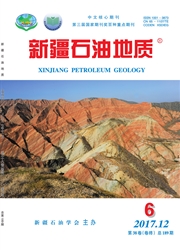

 中文摘要:
中文摘要:
穿越西准噶尔造山带、准噶尔盆地和博格达山布设了奇台-克拉玛依-额敏、五彩湾-三台-博格达人工地震测深剖面,获得了二维速度结构、深部地壳构造和沿探测剖面的地壳分层结构,确定了B、G、C1、C、M等界面和P波、S波分层速度结构和波速比结构,将地壳分为上地壳和下地壳;上地壳包括准噶尔盆地基底之上的沉积层(G界面之上)、G—C1、C1-C界面,下地壳介于C和M界面之间;沿剖面发现了达尔布特、克拉玛依、大拐东、阜康和博格达北缘地壳深断裂带以及盆地腹部4条产状近陡立的超壳断裂,发现了西准噶尔造山带之下T界面埋深11.6~12.4km,向西倾的加依尔冲断推覆构造底部逆冲断层面;确定了博格达山壳幔分界面的明显不连续性,M面埋深由50.6km向南急剧倾斜加深至69.0km,博格达山北缘断裂带浅表倾角较缓,向深部倾角变陡,形成深浅部造山的不协调。
 英文摘要:
英文摘要:
The seismic reflection/refraction profiles are arranged along Qitai-Karamay-Emin, Wucaiwan-Santai-Bogda cross West Junggar mountain, Junggar basin and Bogda mountain, ascertaining 2D crustal velocity, deep crustal structures and crustal layers and acquiring B, G, C1, C, and M interfaces and velocity structures of P, S wave as well as their velocity ratios. The study shows that the earth crust in this region can be divided into upper crust and lower one. The upper crust includes sediments above the basement faults lying on G, G-C1, C1-C interfaces; the lower crust appears between C and M interfaces, there exist deep fault zones such as Dalbute, Karamay, East Daguai, Fukang and northern margin of Bogda as well as 4 steep dipping super-crustal faults in hinterland of Junggar basin. The interface T under the West Junggar orogenic belt is buried in depth of 11.6-12.4 km, and the thrust fault surface at bottom of west-dipping Zhayier nappe structure is recognized. In Bogda mountain area, there is a discontinuous interface between crust and mantle which is sharply deepen toward south from 50.6 km to 69.0 km in depth. In its northern margin, the fault belt is in gentle dipping at the surface and then steep dipping toward the deep, forming the disagreement of orogeny between the surface and the deep.
 同期刊论文项目
同期刊论文项目
 同项目期刊论文
同项目期刊论文
 期刊信息
期刊信息
